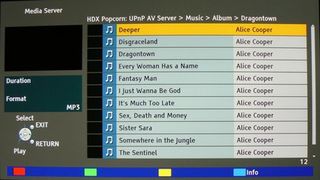Why you can trust TechRadar

Unlike its 3D TV competition, the P50VT20B has both Freeview HD and Freesat tuners which means you get plenty of non-subscription hi-def on tap.
We hooked up both tuners, and found that as a user experience the Freesat option came out on top.
The key transpires to be the EPG environment. The Freesat user interface may not win any beauty contests, but it's simple to navigate and easy on the eye. The Freeview HD EPG however, powered by Guide+ (and supplied by former copyright busters Macrovision, now called Rovi) is compromised.
The problem is that the listing space has been compacted in order to add advertising.

On a practical level this restricts the available area for information. It's also visually distracting, flashing, blinking and twitching away. There is no way to disable the ad.
Connectivity
Backside connectivity is good, and includes two Scart inputs, one set of component jacks with matched phono audio output, Ethernet port and three v1.4 HDMIs.
There are extra inputs on the side, including a CI card bay, SD card slot, two USBs and an additional HDMI.
The P50VT20 is one of a number of new TVs that enables basic programme recording onto an attached USB hard drive. Its use is limited though. The hard drive needs to be registered to the set, and no other channel can be selected while a programme is being recorded.
DNLA networking
The TV is DNLA compliant. Via the Ethernet connection or optional wireless dongle, the screen can find and play content from other networked devices. Once on our network, the TV quickly located all our compliant storage devices.

Video file support includes AVI, HD MKVs and DiVX, music is restricted to MP3s. You can also go online to Panasonic's own Viera Cast content portal. Outside of YouTube and Picasa there's not much of note to be seen, however new content additions are planned.

Picture processing modes
There's no shortage of picture processing options within the screen's menus.
There's a variety of other picture processing modes available. C.A.T.S is an automatic contrast tracking function which adjusts picture content dependent on ambient light; P-NR is a noise reduction filter; 3D-Comb is a patterning filter for legacy connections.
There's also Picture-in-picture and Picture-and-picture modes.
Intelligent Frame Creation
TV brands are currently embroiled in a battle to offer the fastest possible screen frame refresh rates.
Different techniques are employed, ostensibly to reduce motion smearing artefacts on smeary LCD screens. Cynics might argue that the real goal is to produce the highest possible number on in-store sales collateral.
Plasma is a self-illuminating technology, and has an inherently faster response time than LCD, which means that it doesn't suffer from the same motion artefacts.
But that hasn't stopped Panasonic from joining the numbers game with its 600Hz Sub Field Drive. However the speed rating is a reference to the processing in the silicon rather than a screen refresh rate per se.
The Sub Field Drive is part of the screen's Intelligent Frame Creation (IFC) picture processor.
In the UK, frame refresh rates are typically multiples of 50Hz, in the US they're multiples of 60Hz.
Almost all LCD screens now offer either 100 or 200Hz. By flickering the LCD backlight you can appear to double this, which has led some brands to claim 400Hz. But ultimately, this is a pyrrhic victory. High frame rates destroy the tone and character of film material, leaving everything looking like it was shot on a camcorder. And the execution of IFC is no different here.
I spent some time with IFC engaged but became convinced that it was introducing motion artefacts rather than curing them. These artefacts are unpredictable but jarring. They also change the character of the image. This is one mode I'm happy to leave off. Incidentally, when the screen detects a 1080/24 input, the IFC control changes to 24p Smooth Film. This applies similar processing, so do give it a miss.
THX certification
The P50VT20 is THX certified, which basically boils down to a picture preset optimised for movie viewing, which removes overscan and gives 1:1 pixel matching.
While this is ideal for playback of Blu-rays, it may present some problems when watching TV material as pulsing white image data, never intended to be seen, can become visible at the extreme edge of the frame. Still, correcting overscan is a must-have viewing option.
For what it's worth, some plasma buzz was evident, depending on picture content. In most circumstances this is masked by volume, but we were aware of it.
Current page: Panasonic TX-P50VT20B: Features
Prev Page Panasonic TX-P50VT20B Next Page Panasonic TX-P50VT20B: Picture qualityHome entertainment AV specialist
Steve has been writing about AV and home cinema since the dawn of time, or more accurately, since the glory days of VHS and Betamax. He has strong opinions on the latest TV technology, Hi-Fi and Blu-ray/media players, and likes nothing better than to crank up his ludicrously powerful home theatre system to binge-watch TV shows.

Meta’s massive OS announcement is more exciting than a Meta Quest 4 reveal, and VR will never be the same again

World's fastest broadband connection went live down under — Nokia demos 100 gigabit internet line in Australia in record-breaking attempt but doesn't say when it will go on sale

Don't miss the Samsung Galaxy S23 Ultra for just $849 at Best Buy right now

